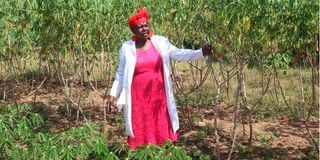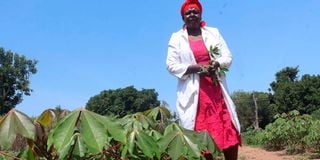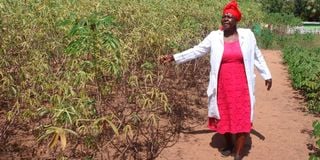From 'poor man's crop' to gold: Meet the woman behind cassava revolution

Ruth Okoth at her cassava farm in Kamingusa Village in Rachuonyo North in Homa Bay County on September 30, 2024.
What you need to know:
- Ruth Okoth, a 58-year-old retired teacher in Homa Bay County, has transformed her farm and community by pioneering cassava cultivation.
- Once dismissed as a "poor man's crop," cassava is now emerging as a solution to food security challenges, thriving in harsh climatic conditions where other crops fail.
- Ruth's innovative approach has caught the attention of researchers and expanded market opportunities.
International Day of Rural Women
The scorching sun beats down on the lush green fields of Kamingusa Village in Homa Bay County. The air is thick with the earthy scent of freshly tilled soil and the sweet aroma of ripening fruit. Amidst this pastoral scene, an unexpected revolution is taking root – and at its heart stands Ruth Okoth, a 58-year-old farmerwhose weathered hands tell a story of transformation – not just of her land, but of an entire community's perception of what was once dismissively called "the poor man's crop."
Welcome to Dala Ka japur, the "farmer's home," where the air buzzes with the promise of change and the earthy aroma of freshly harvested cassava fills the nostrils.
"I mainly grew maize, which we consumed at home," Ruth recalls her past, her eyes twinkling with the memory of simpler times. But as she speaks, her gaze sweeps across acres of thriving cassava plants, their broad leaves rustling in the warm Rachuonyo breeze.
Ruth's journey from a small-scale maize farmer to a cassava pioneer is a testament to the power of vision and adaptability. As a former adult education tutor, she spent years balancing her time between nurturing minds at Kajiei Primary School and tending to her modest farm. But the landscape of agriculture was shifting, and Ruth was determined to shift with it.
"Maize was becoming a common crop in the village, and there was no profit in farming," she explains. This realisation sparked a quest for innovation that would eventually reshape the agricultural landscape of Kamingusa Village.
Ruth's agricultural epiphany didn't happen overnight. It was a gradual process, nurtured by years of experience and a thirst for knowledge that took her far beyond the borders of her village.

Ruth at her farm. Her journey from a small-scale maize farmer to a cassava pioneer is a testament to the power of vision and adaptability.
"Throughout my life, I have gained a lot of experience in farming, including travelling to Israel, South Africa, Ethiopia, and Mali, where I learned about modern agriculture," she shares, pride evident in her voice.
The turning point came in 2015 when she made a decision that raised eyebrows in her community – she introduced cassava to her farm.
"Its demand is on the rise, and farmers need to know this," she asserts, her tone leaving no room for doubt.
Today, her farm is a testament to her foresight. On a one-and-a-half-acre plot, two sets of cassava stand tall – one planted in May, promising a bountiful harvest by January next year, and another ready to yield its starchy treasures at any moment.
But Ruth's vision extends beyond mere cultivation.
"Cassava can survive in harsh climatic conditions and is one of the best crops that can adapt well to any weather," she explains. "It is a solution to the food crisis as it can survive when other crops fail due to weather changes."
This resilience is turning cassava into a golden crop for farmers in Karachuonyo and beyond. The demand is skyrocketing, driven by an expanding market that goes far beyond traditional consumption.
"Most high-end hotels in the country sometimes include cassava in their breakfast menu," Ruth notes, a hint of pride in her voice.
From the humble beginnings of juice-making with oranges and mangoes, she now supplies hundreds of kilograms of cassava to various groups for commercial purposes. The crop's versatility is astounding – from breakfast staples to midday snacks, from ugali to industrial starch, cassava is carving out its place in kitchens and factories alike.
But Ruth's ambitions don't stop at the farm gate.
"We intend to establish a cooperative society which we will use to seek help from different organisations," she reveals, her eyes alight with the possibilities of value addition and expanded markets.
The potential is enormous, but challenges remain. Financial constraints hinder her dreams of venturing into value addition, with the necessary machinery lying just out of reach. Yet, she remains undaunted.
"We made juice and sold it to neighbours," she reminisces about her early days of diversification. It's a reminder that great ventures often start small.

Ruth Okoth, a former adult education tutor, spent years balancing her time between nurturing minds at Kajiei Primary School and tending to her modest farm. But this has since changed.
As the sun begins to set over Dala Ka japur, casting long shadows across the cassava fields, Ruth's determination shines brighter than ever. Her farm has become more than just a source of food and income – it's a beacon of innovation, a testing ground for new ideas.
The Kenya Agricultural Research Organisation (Kalro) has recognised the potential, using local farms like Ruth's to conduct research projects on cassava farming.
"They are seeking to identify new cassava seeds that are drought tolerant," Ruth explains, her role in this research adding another layer to her growing legacy.
In Kamingusa Village, nothing goes to waste. Cassava leaves find their way to dinner plates as vegetables, while the peels serve as nutritious poultry feed. It's a holistic approach to farming that maximises every part of this versatile crop.
As we stand at the edge of her thriving cassava plot, Ruth's words hang in the air, a challenge and a promise rolled into one: "I have plans to increase cassava production by expanding the size of land."
In the fading light, with the cassava leaves whispering secrets of resilience and adaptability, one thing becomes clear: the future of farming in Kamingusa Village is taking root in Ruth Okoth's fields. And it's a future that promises to be as rich and nourishing as the humble cassava itself.





